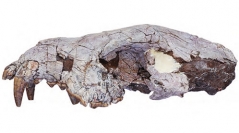

 Geodiversitas
31 (4) - Pages 753-773
Geodiversitas
31 (4) - Pages 753-773Phoberogale Ginsburg & Morales, 1995, is a primitive ursid named to separate hypercarnivorous species from a rather heterogeneous group formerly included in the genus Cephalogale Jourdan, 1862. The presence of Cephalogale (s.l.) in the Great Plains of the United States has been documented since the late 1980s, often in the context of immigrant taxa and Neogene biochronology. However, no formal description or illustration of the respective specimens was published. Recently, an associated skull and left dentary were recovered from an early Miocene terrestrial deposit in southern California. We take this opportunity to describe the California specimen, which represents a new species, Phoberogale shareri n. sp. This new species belongs to the Phoberogale-Phoberocyon lineage and is distinguished from species of Cephalogale (s.s.) by its larger size, less-reduced pre-carnassial premolars, and less-elongated M2. Within the genus Phoberogale, P. shareri n. sp. is more derived than Europeans species (P. bonali, P. depereti, P. ginesticus) as indicated by its larger size and more differentially enlarged p4 compared to the p3. It differs from Pakistani P. bugtiensis in having a less prominent notch between the anterior base of the P4 paracone and protocone, a more distinct anterior ridge on the P4 paracone, and more mediolaterally shortened M1-2. Phoberogale shareri n. sp. represents the first known Pacific Coast occurrence of this lineage and has important zoogeographic and biochronologic implications. RÉSUMÉ
Mammalia, Carnivora, Ursidae, systematics, zoogeography, Miocene, California, new species